Foot corns are a silent epidemic.
Many people have them yet never publicly talk about it.
A recent study found that over 75% of people experience some kind of podiatric problems, many of which include foot corns.1Lisa Farndon, Andrew Barnes, Keith Littlewood, Justine Harle, Craig Beecroft, Jaclyn Burnside, Tracey Wheeler, Selwyn Morris, Stephen J Walters
. Clinical audit of core podiatry treatment in the NHS
, J Foot Ankle Res
. 2009
This article discusses foot corns and the best ways to remove them.
What Are Foot Corns
Foot corns are small, thick, hard patches of skin that form on your foot. Not surprisingly, they look a lot like a kernel of corn.
They typically come from continuous pressure and friction on your foot.
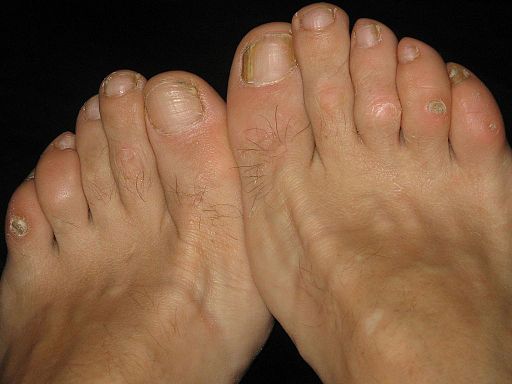
In many cases, there is a direct link between wearing tight-fitting shoes and developing corns.
Other foot maladies, such as hammertoes or bunions, cause corns due to deformed bones rubbing against your shoes.
Unlike a callus, made up of dead cells and skin hardened into a protective outer layer of skin, foot corns can be extremely painful.
Hard Corns vs. Soft Corns
Foot corns can be classified as either hard or soft, mainly describing its inner core and where it’s located on your foot.
Corns mostly appear on toes.2American College of Foot and Ankle Surgeons. Corns, foothealthfacts.org/
Hard Corns
A hard corn is made from very thick dead skin with a hard inner core.
Hard corns are usually found on the tops of toes.
They are caused primarily by wearing tight-fitting shoes (i.e., high heels) that cause the tops of toes to rub against the shoe.
Soft Corns
Soft corns are thinner than hard corns and show up as painful little bumps that sprout up between any of the toes.
They usually turn up between the fourth and fifth toes.
The pain of soft foot corns comes from continuous friction and the pressure that comes from ill-fitting shoes.
Seed Corns
Seed corns are similar to small calluses and typically appear on the bottom of the feet.
If you put weight on the seed corn while walking, running, or exercising, it can be painful.
Seed corns are believed to come from plugged sweat ducts in the feet.
Fibrous Corns
Fibrous corns are corns that have been on your feet for an extended period.
Out of all different types of corns, fibrous corns attach to deep tissues in your feet.
These corns can be painful.
Vascular/Neurovascular Corns
These types of corns have also been present on your feet for some time.
They have both blood vessels and nerve fibers, and eventually, they move deep within your feet and attach firmly to tissues there.
If cut, these corns will bleed and cause a lot of pain.
Do Corns Have Roots?
Contrary to common belief, corns do not have roots, although deep-tissue corns may feel like they do.
Corns are made from dead, thick skin, which hardens.
These small, hard lesions attach themselves to bony areas of the foot, like toes.
Corns Vs Calluses
Before you can appropriately treat your foot condition you must correctly identify the problem.
Corns and calluses are often confused for one another.
While they may seem similar, there are some major differences between the two.
Correctly distinguishing between a corn and callus can help save you time and money on treatments.
Calluses
Calluses are larger than corns, come in different sizes, and appear in various locations on the feet.
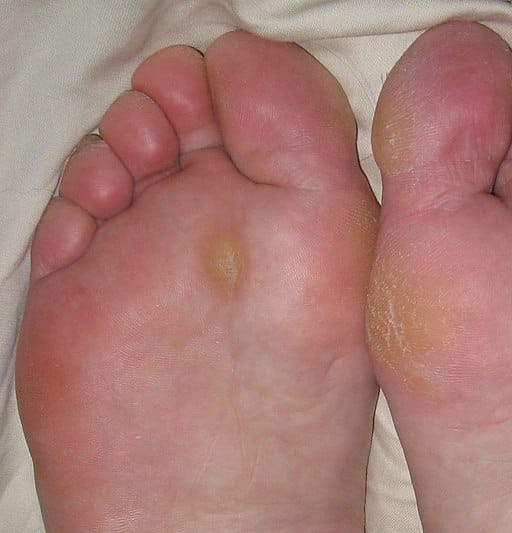
Calluses appear on the balls, heels, and soles of the feet.
They’re also found on the sides and bottoms of toes.
A callus consists of thick, dead, hard skin that acts as a protective layer to the underlying surface. A callus is caused by applying constant pressure or friction to the affected area and is usually not painful.
What Causes Foot Corns?
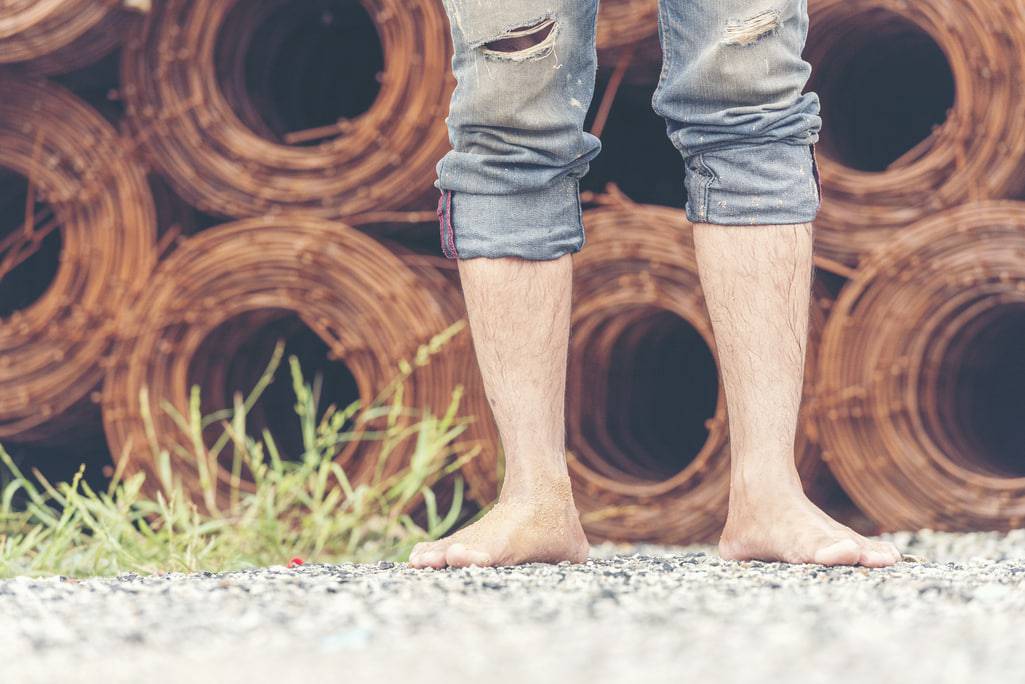
There are a number of root causes that lead to foot corns. Many pertain to proper foot hygiene including:
- Ill-fitting shoes
- Added shoe material that causes friction
- Not using socks
- Walking barefoot
- Poor foot position while running or walking
- Bad posture
While these practices may seem harmless, over the longterm they can lead to complications like corns, calluses, and dry feet.
Each of these contributes to adding pressure, friction, and strain on your feet.
This is a perfect recipe for foot corns.
Added Risk Factors For Foot Corns
There are some added risk factors that include chronic health conditions which require a more comprehensive protocol including:
- Bone Spurs
- Hammertoes
- Bunions
- Age
- Diabetes
- Poor circulation
Bone spurs
Bone spurs are bone protrusions that form along the edges of your bones in areas like the hips or spine.
Bone spurs can also develop in the joints, where bones join together.
This condition causes discomfort and pain due to the spurs rubbing against the bones, causing permanent joint damage and is a symptom of osteoarthritis.
Hammertoes
Hammertoe is an affliction of the toes that results in the permanent, unnatural bending in the middle joint of your toes. Because of the abnormality of one toe, it negatively affects the toe right next to it.
Hammertoes are painful, mobility becomes limited, and the development of corns and/or calluses is likely. Wearing narrow toe shoes like high heels makes the condition worse.
Bunions
Bunions affect the big toe and develop when the joint connecting the foot to the big toe pushes into the adjoining toe. These painful, bony bumps cause stiffness of the joints and toes, along with permanent toe deformities.
Bunions are caused by wearing tight shoes and arthritis.
Age
A recent study found that as you age, the odds of experiencing foot corn increases.3Martin J Spink, Hylton B Menz, Stephen R Lord. Distribution and correlates of plantar hyperkeratotic lesions in older people, J Foot Ankle Res. 2009
Poor circulation, joint/muscle pain, arthritis, decrease in range of motion, and limited mobility are all a result of aging and negatively impact feet of the elderly. Pain in the knees, spine, and hips create uneven postures, placing more strain on one of the feet.
A mix of these age-related issues creates the perfect conditions for calluses and painful corns to set in.
Diabetes
People who have diabetes are prone to develop corns and calluses. This is due to poor circulation, nerve damage, and dry, dehydrated skin in extremities like the feet.
Professional medical treatment may be required to heal and prevent the onset of corns and calluses on diabetic feet.
Poor Circulation
Peripheral Arterial Disease, or PAD, also referred to as “poor circulation,” prevents proper blood flow to the legs and feet. The arteries in the legs narrow, making it difficult for enough oxygen and blood flow to reach the feet.
Pay special attention to your feet if you experience tingling, constant coldness, or numbness, especially if there is a family history of poor circulation or heart disease.
Can Corns be Removed?
Corn removal can be done by using in-home treatments. For more severe corns, medical intervention or surgery may be an option.
The key is to identify and remove the cause of the corn.
The primary cause of corns is causing constant friction to the toes and feet.
Lifestyle changes to reduce friction such as proper fitting shoes, improving posture, losing weight, and wearing shoes instead of going barefoot can help.
How Long does it take for Corns to Go Away?
Corns will go away when you identify the source of friction to the feet and toes.
Once the friction stops, the corn will go away on its own within 7 to 30 days.
If you want to speed up the process, gently exfoliate the corn and keep skin moisturized.
What Happens if a Corn is Left Untreated?
Untreated corns not only cause additional pain but can lead to more serious deeply rooted corns, which are harder to remove.
Untreated corns can also bleed, blister, become infected, or lead to permanent bone/joint damage or arthritis.
Why are Corns so Painful?
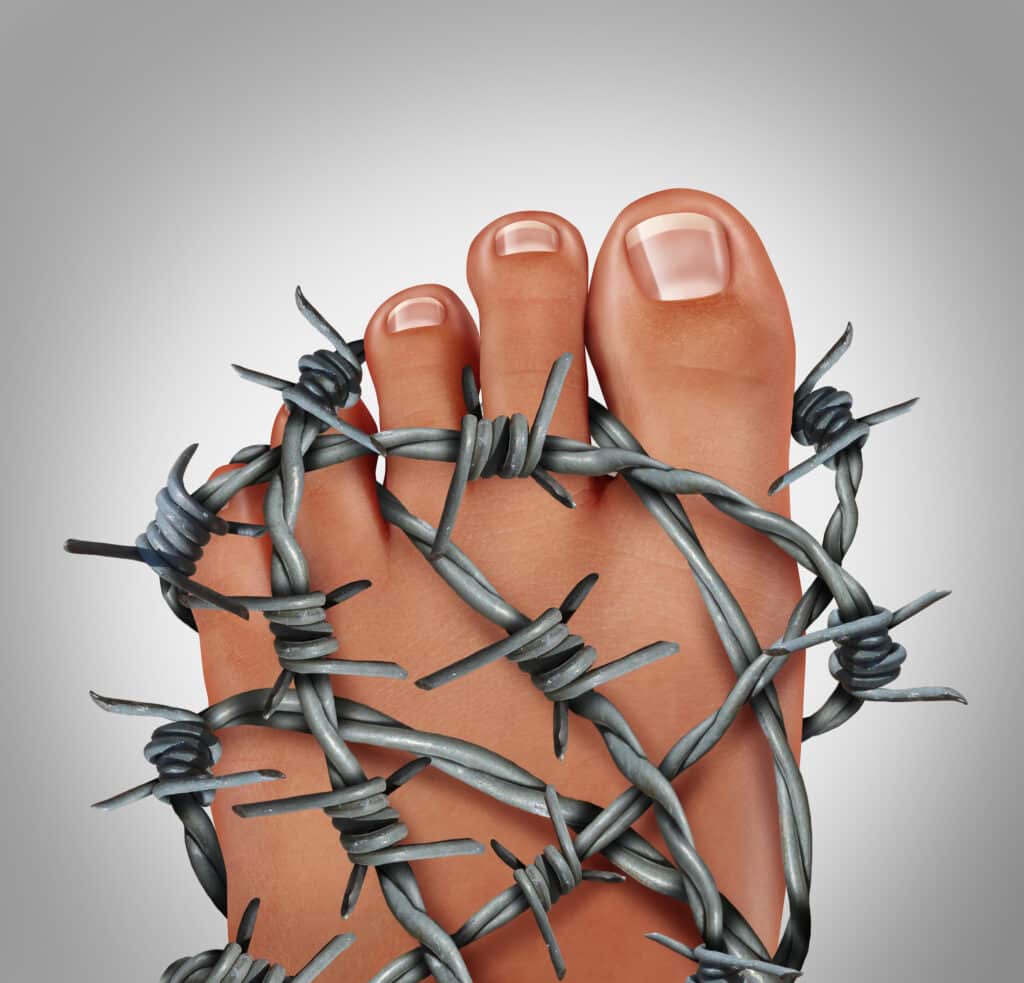
Because corns are hard and located on or between the toes, they hit nerves, which causes intense pain. Depending on the location of the corn, any pressure, friction, or extra weight in a tender area can result in extreme pain.
What Happens if a Corn Bleeds?
If a corn or callus is cut and bleeds, it significantly increases the risk of infection.
If pus or clear fluid comes out of the corn or callus, it’s probably infected.
Contact your doctor immediately.
Best Corn Removal Products
The following products are effective at removing foot corns:
- Electric Callus Remover
- Foot Soaks
- Moisturizers
Electric Callus Remover
In addition to products used first to soften the hard, thick skin of a corn or callus, one of the most productive corn removal products is an electric callus remover.
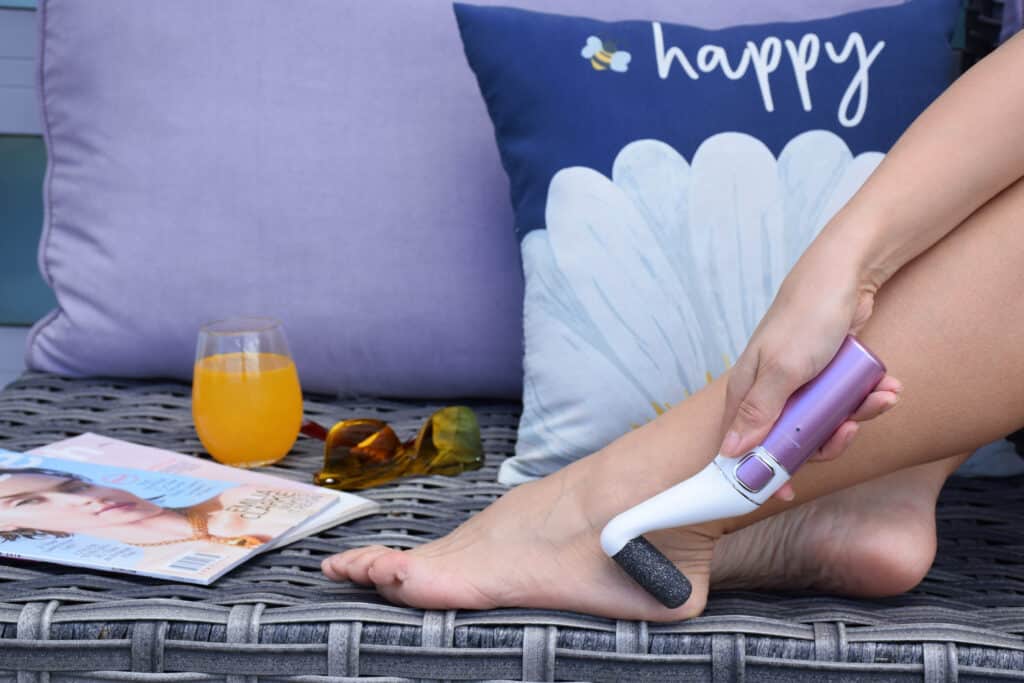
It’s one of the safest and fastest ways to exfoliate that top hard layer of skin for new, softer skin to emerge.
If you want fast results for attractive feet and to eliminate pain quickly, reach for our Editor’s Choice: Electric Callus Remover by Own Harmony.
Foot Soaks
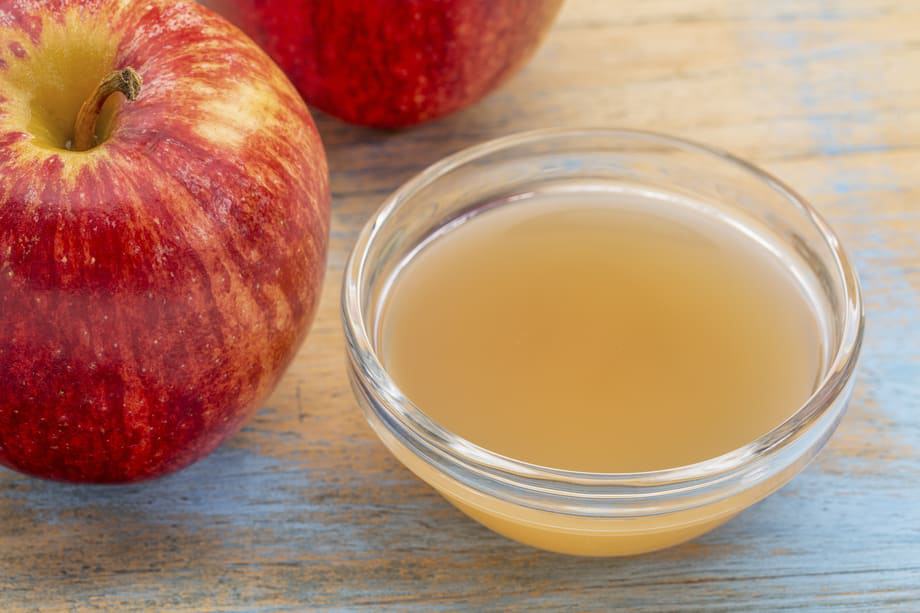
Vinegar: A 10-minute foot soak using white or apple cider vinegar, which contains antibacterial properties, works to soften corns for easier removal with an electric callus remover or pumice stone.
Soak feet in lukewarm – not hot – water with approximately ¼ cup of vinegar to prevent further drying of the skin.
Listerine: It’s odd to think about soaking your feet in mouth wash, but it helps kill fungus, eliminates some bacteria, cleans, and sweetens up stinky feet.
If you’re up for it, the official recipe calls for ¼ cup Listerine (any variety), ¼ cup vinegar (any type), and ½ cup of warm or somewhat cold water. Soak for about 10 minutes, pat dry, and exfoliate.
Moisturizers with Softening Agents
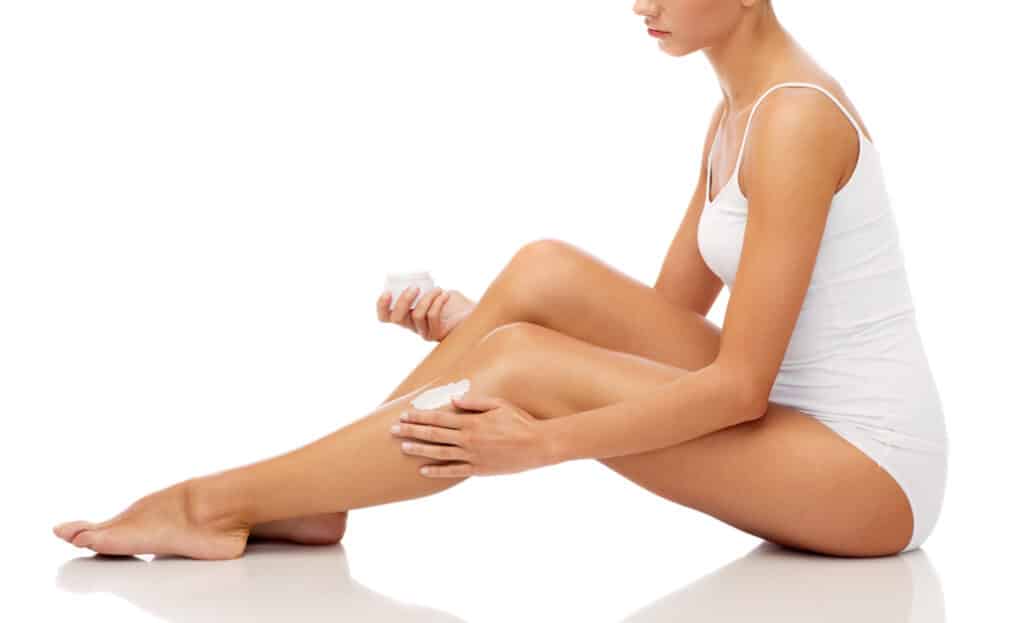
Salicylic acid, a keratolytic, is commonly used to treat warts, causing them to peel away. It’s useful because it increases moisture retention in the skin while causing the sticky substance that forms the hard layer of skin in warts, calluses, and corns to dissolve for removal.
Urea: A moisturizer containing urea also works as a softening agent, making corns and calluses easier to remove once the hard layer of skin wears away.
Ammonium lactate: Moisturizers containing ammonium lactate work by using alpha hydroxy acids to provide natural exfoliation of thick hard skin caused by corns or calluses. It also helps keep skin hydrated while it exfoliates.
Corn removal pads
Corn removal pads are specially designed to help eliminate painful corns.
First, cut the pad down to size to cover only the area of skin needing treatment, not the surrounding skin. It’s as easy to use as a band-aid.
Change the pad once or twice per day for about two weeks for the complete removal of corns.
Foot masks
Foot masks come complete with natural exfoliators such as alpha hydroxy or fruit acids. Slide the booties on for about an hour, and the acids go to work to naturally soften and peel away hard, thick corns and calluses.
Disclaimer – Complications with Home Corn Removal
Attempting to slice, cut, or burn off the corn is a serious no-no. It causes additional pain, bleeding, draining of fluids if infected, causes infection, and other serious injuries.
Follow product instructions carefully and discontinue use if you experience redness, inflammation, tingling, burning, or pain. Seek medical attention if your condition worsens.
Foot Corn Prevention
Prevention is the best method for long-term avoidance and treatment of pesky foot corns. These methods include:
Give Feet TLC
Foot soaks, massages, consistent exfoliation, and using hydrating moisturizers will help heal and prevent further corn and/or calluses from forming.
Don’t forget to trim toenails. If toenails are too long, they push toes together or against your shoes enough to irritate corns or calluses to form.
Use Corn-Specific Protective Padding
If you have discomfort while wearing shoes, wear corn-preventing padding inside to protect your skin. These pads work by positioning your toes more comfortably to prevent excessive rubbing and friction, decreasing the chances of reoccurring corns and calluses.
Wear Proper-fitting Shoes with Plenty of Toe Room
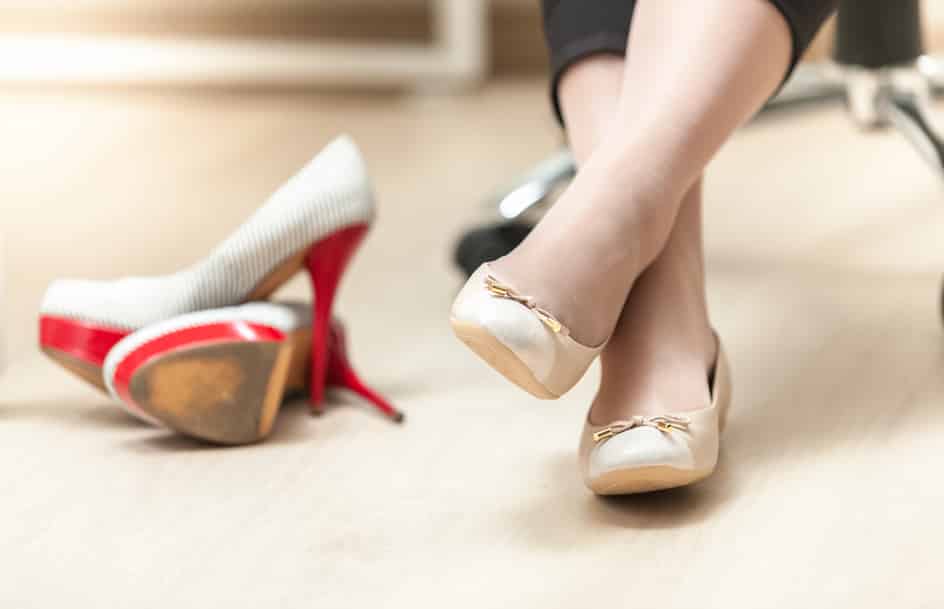
The biggest takeaway of all is to wear only shoes that fit properly with enough room for your toes to be comfortable.
This alone is the “ounce of protection” that prevents your chances of getting corns and calluses in the first place.
When You Should Consult a Podiatrist
It’s time to call a podiatrist if you have extremely painful or irritated corns or calluses.
Your condition may be too involved for successful home removal or should be checked for a more serious medical condition.

